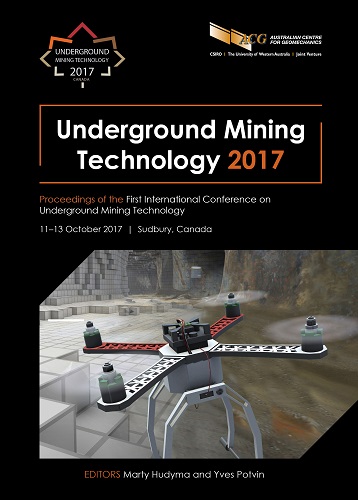Ventilation control system implementation and energy consumption reduction at Totten Mine with Level 4 Tagging and future plans

|
Authors: Acuña, EI; Allen, C |
DOI https://doi.org/10.36487/ACG_rep/1710_06_Acuna
Cite As:
Acuña, EI & Allen, C 2017, 'Ventilation control system implementation and energy consumption reduction at Totten Mine with Level 4 Tagging and future plans', in M Hudyma & Y Potvin (eds), UMT 2017: Proceedings of the First International Conference on Underground Mining Technology, Australian Centre for Geomechanics, Perth, pp. 89-95, https://doi.org/10.36487/ACG_rep/1710_06_Acuna
Abstract:
Totten Mine has been operating a ventilation control system (VCS) with remote activation capabilities under a manual mode since 2014. The system consists of on/off and variable frequency drive fans, variable opening louvers and doors to regulate the airflow across levels, ramps and headings. Parameters that are monitored within the VCS include air volume, relative humidity, dry bulb temperature and carbon monoxide. All of the VCS components installed and commissioned in 2014 were operational during the mine production ramp-up from 2015 to 2016. The managed ventilation system demonstrated its ability to accommodate the airflow requirements of the mine in an effective and efficient manner during this time. However, changes to the mining plan generated an increase in required air volumes. It was determined these could be accomplished by further enhancements of the ventilation control system. As a result, during 2016 the automation and ventilation departments reviewed the alternatives available in the market and selected the NRG1-ECO software provided by Bestech to achieve a tag and tracking-based level of automated ventilation control. The implementation of the software started at the end of 2016 with a single level and was then expanded to additional levels. This paper presents the state of the current VCS at Totten Mine in terms of the levels that have been commissioned, the control strategies in use and the energy reduction achieved in the range of 50 to 60%. These are compared to the baseline established before the implementation. Challenges encountered during commissioning, maintenance and the plan for future implementation and software versions are also discussed.
Keywords: ventilation control system, mine wide implementation, measured and estimated savings
References:
Acuña, E & Allen, C 2017, ‘Totten Mine ventilation control system update: Implementation and savings achieved at Level 1 Manual Control’, in JF Brune (ed.), Proceedings of the 16th North American Mine Ventilation Symposium, Colorado School of Mines, Golden, chapter 3, pp 7–14.
Acuña, E, Alvarez, R & Hurtado, JP 2016, ‘Updated ventilation on demand review: Implementation and savings achieved’, Proceedings of the 1st International Conference of Underground Mining, in R Castro & M Valencia (eds), pp. 606–617.
McPherson, M 1993, Subsurface Ventilation Engineering, Mine Ventilation Services, Clovis, USA, viewed the 21 February 2017, .
Natural Resources Canada 2017, List of CANMET-MMSL Approved Diesel Engines for Use in Underground Mines and Confined Locations Such as Tunnels, Natural Resources Canada, Ottawa, viewed 5 July 2017,
Queen’s Printer for Ontario 2016, R.R.O 1990, Reg. 833: Control of Exposure to Biological or Chemical Agents, version 1 July 2016, Queen’s Printer for Ontario, viewed 25 July 2017,
Queen’s Printer for Ontario 2017, R.R.O 1990, Reg. 854: Mines And Mining Plants, version 1 January 2017, Queen’s Printer for Ontario, viewed 25 July 2017,
Tran-Valade, T & Allen, C 2013, ‘Ventilation-On-Demand key consideration for the business case’, Proceedings of the Toronto 2013 CIM Conference, Canadian Institute of Mining, Metallurgy and Petroleum, Westmount.
© Copyright 2025, Australian Centre for Geomechanics (ACG), The University of Western Australia. All rights reserved.
View copyright/legal information
Please direct any queries or error reports to repository-acg@uwa.edu.au
View copyright/legal information
Please direct any queries or error reports to repository-acg@uwa.edu.au